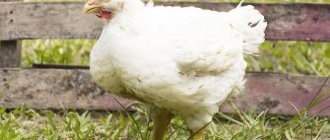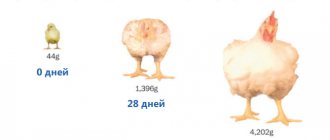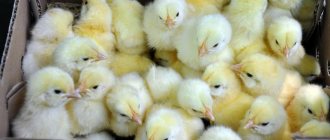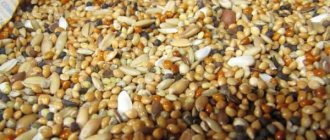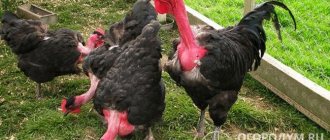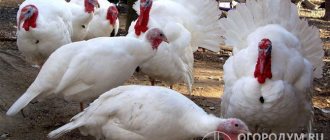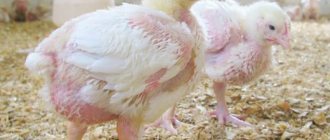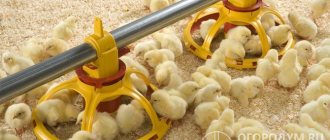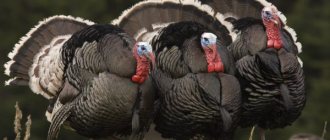Broiler cross is an early maturing type of chicken that is becoming increasingly popular among poultry farmers. For such chickens it is absolutely not necessary to purchase expensive feed; you can prepare your own compound feed for broilers.
Despite this, very often even experienced poultry farmers fail when breeding this type of meat chicken. Below we will look in detail at what it should be like to breed broilers at home for beginners and how to organize the care of this breed in order to get a good meat bird.
What you need to know about breeding?
There are two ways of breeding broiler chickens - intensive and extensive:
- Intensive (production) housing consists of limiting the movement of broiler chickens from the moment of hatching in a cage or deep floor litter and feeding the chickens with complete dry feed.
- With the extensive method of rearing, which is most suitable for a peasant or farm enterprise, the poultry is kept in equipped chicken coops and cages, moves freely around the range, and receives a variety of feed types and composition.
When keeping birds “free”, a poultry house is equipped. Day-old chicks and commercial poultry require space at the rate of 12-15 birds per 1 m².
With cage rearing, up to 18 broilers are placed per 1 m², but the meat of such birds will be denser and tougher. There are several options for cells that are made independently or purchased ready-made. Cells are assembled into structures similar to cassettes or batteries.
Most private poultry farmers prefer the floor method of growing in a chicken coop on litter.
To do this, the floors are covered with sawdust, straw, shavings, and fibrous peat. To comply with sanitary and hygienic standards, damp lumps are regularly removed, mixed and filler is added.
In the summer, growing broiler chicks and adult chickens are released outside into a fenced paddock. If the walk is well protected from drafts, for example, by previously used window or greenhouse frames, the chicks are released onto the “grass” from the age of one month.
Temperature
Broiler chickens require strict adherence to temperature and humidity in the areas where they are kept. Humidity throughout the growing period should be between 60-70%.
For heating, household and industrial heaters and infrared lamps are used.
Day-old chicks are fenced off, limiting their distance from the heat source, maintaining a temperature of + 32°-35°C. From the second week, a gradual decrease in temperature begins. 6-10 day old chicks require t + 32°-30°C. 11-20 days - t + 28°-26°С. Starting from the third week, t +24-20°C is required.
Important! Chickens up to 2-3 weeks of age have an underdeveloped digestive system; they are not able to independently maintain optimal body temperature.
To prevent hypothermia of the abdomen and colds, it is necessary not only to maintain the temperature regime, but also to warm the bedding.
Lighting
Until the 5th day, the coop is illuminated for 20-24 hours. At a week of age, when the chicks begin to distinguish between day and night, they begin to interrupt the lighting for 10-15 minutes every 2 hours, gradually increasing the daylight hours to 16-17 hours.
Ventilation
The poultry house must be equipped with ventilation and exhaust hood. A constant supply of clean air is vital for broilers.
Feeders and drinkers
Before reaching a week of age, the feeder is filled to the brim. As soon as the chicks acquire the skills of self-feeding, feeders and drinkers are filled ¼ full and raised above floor level to avoid contamination of the litter with food.
Raising broiler chickens is profitable. By following simple requirements, you can not only provide your family with environmentally friendly, dietary chicken meat, but also achieve a small profit when selling broiler meat.
Pros and cons of breeding
Advantages:
- High productivity and growth. The weight of a broiler by the 6th week of growth can reach 2-2.5 kg, as a result, after 50 days of growth - up to 3 kilograms per chicken, and up to 5 kg. with a cockerel. A real giant, and potentially profitable.
- High-quality products with an excellent proportion of white and red meat, in case of proper care, absence of sources of stress and a varied diet.
- The broiler does not require large spaces; at the initial stage (brooder), it is possible to place up to 18 chicks per square meter, which allows the use of small garden plots as a mini-poultry farm.
Flaws:
- The need for constant feeding, high food costs. The bird will not gain weight on pasture; for adequate nutrition of broilers, clean water of average temperature, high-quality, safe and varied food with a clear feeding schedule are needed.
- In case of errors with the selection of products, death and various diseases are possible.
- Due to the increased crowding and inactivity of broilers, the room with chickens must be cleaned of waste daily (also, feeders and drinking bowls must be washed with soap every week), prepared in advance for moving in, monitor the health of the birds, regularly feed them with antibiotics and vitamins, house weak birds separately, place on an autonomous diet to avoid death or pecking.
- High humidity and temperature changes are unacceptable. It is necessary to ensure high-quality ventilation of premises, while avoiding drafts or cold, which lead to illness, weight loss and mortality. This fact makes creating a room for breeding broilers a difficult and expensive task.
How to choose chickens?
Breeds
Broilers are the result of targeted selection work to breed a hybrid to quickly obtain high-quality dietary meat products.
The most popular broiler crosses among Russian poultry farmers are KOBB-500, ROSSy-38, 708, Gibro-6, Broiler-61, M. Crosses Smena and Hubbard F 15.
Manufacturers
It is safer to buy broiler chickens from private farms that have proven themselves on the market and at specialized hatcheries.
As a rule, chickens purchased from such producers are viable, active and already vaccinated against major diseases.
The price of broilers offered by large poultry farms is lower, but there is a vicious practice of factories selling culled weak young animals.
The cost of chickens varies depending on age, breed, region, and time of year from 35 to 95 rubles per head.
Age
Experienced poultry farmers who know the intricacies of keeping and have equipped areas for rearing prefer to buy cheaper day-old chicks.
Beginners are advised to purchase young animals aged 5-10 days, as they are easier to care for.
Viability
Healthy, viable broiler chickens are selected for the following characteristics:
- Chickens are active, mobile, responsive to sounds, with a good appetite;
- Clear eyes with sparkle;
- Soft tummies;
- The wings are pressed tightly to the body;
- The feathers on the wings of cockerels are the same length;
- Absence of sea otter plumage;
- Smooth pubescence, without “tufts”.
Important! The crosses ROSS 308 and COBB 500 have slightly enlarged and rounded tummies. The beak and legs may have a bluish tint.
Rooster or hen
For meat broilers this is not a big deal, but if you want to choose, you can find out the sex at chick age by the wings. Spread your wing.
A rooster's feathers will be the same size, while a chicken's feathers will be of different lengths. Regardless of gender, you need to choose chickens that are mobile, active, and have shiny, clear eyes.
If the chicken is weak, sits all the time, and its eyes are cloudy, it is sick and will not live long. A healthy chicken's tummy is soft, not bloated, and tucked up.
The fluff is uniform, the wings in a calm state are not spread out, but tightly pressed to the body. Healthy chicks respond well to sound. If you knock on the box or box in which they are placed, they will rush towards the source of the noise.
Features of cultivation
Contents on litter
Here, an important role is played by the filling on the floor, so its composition is of great importance. It should be loose, dry, hygroscopic, and absorb harmful gases. The optimal bedding option is well-dried sawdust without large fractions, pieces of wood and bark.
Arrangement of the premises:
- The floor is covered with quicklime powder - one kilogram per square meter of area.
- A layer of sawdust of at least 10 cm is placed on top of the lime layer.
- If you purchased one-day-old chicks, make sure that the room is illuminated around the clock.
- Good ventilation should also be provided.
- In the first weeks, the chicks need a high temperature - from +26°C to +33°C. It is especially necessary to ensure that it does not drop at night.
- After a month, the temperature can be reduced to +20°C and maintained at approximately this level (not lower than +18°C) throughout the entire growing period.
- The air humidity in the chicken coop for young chickens is maintained no higher than 65%; later it can be increased to 70%.
Important! With a decrease, even short-term, the growth of chickens is delayed and they die. Electric heaters will be needed to maintain the required temperature in the poultry house.
Contents in cages
Cage housing has different placement standards - 20 chickens can be raised in the cage space. Moreover, this figure does not change with the age of the young animals.
The cells must be equipped in a special way. When rearing in cages, you can significantly save space by arranging housing for chicks in several tiers on shelves.
It is important to maintain the required temperature in each tier. To grow in cages, the temperature must be higher - +34°C... +35°C, since chickens are deprived of the opportunity to move freely and choose the warmest place, as when kept on the floor. Cage bedding is not needed.
They must be cleaned and disinfected in a timely manner. Keeping them in cages is most welcomed by sanitary and epidemiological stations, as it is hygienic and safe for birds and humans.
The same requirements apply to ventilation and other parameters when kept in cages as when kept on litter.
Transfer of young animals to the chicken coop
The time has come to transfer the young animals to a permanent place - to the chicken coop. Raising meat chickens requires constant cleanliness. The chicken coop is cleaned and whitewashed with lime. Sawdust is placed on the floor and topped up regularly. The excrement is mixed with sawdust and rotted with the release of heat, forming a warm litter.
The feeders are washed with potassium permanganate and dried. The walking area must be clean. They put out troughs with shells, sand and ashes for bathing. Birds should not use the handle of the feeder as a perch, otherwise excrement may end up in the feed. The handle should be rotating.
Not all owners have a brand new block shed. Often the cracks in an old wooden shed are plugged with rags. Before moving the young animals in, we remove all rags. Curious birds love to stick their nose, or rather their beak, where it doesn’t belong. the chicken can get tangled in the threads with its paw or even its tongue. Potato nets are especially dangerous.
Feeding
However, it is not enough to create suitable conditions for chickens and provide them with the proper amount of feed. To quickly produce large, well-fed birds, it is important to choose a balanced, age-appropriate diet.
What to feed broiler chickens? This question is most relevant for all beginners and experienced poultry farmers who have not previously encountered raising such birds.
Homestead farms often practice using home-made wet and dry food.
During the first weeks of the chicks’ stay in the yard, they are fed wet mash based on boiled eggs, millet, crushed oats and wheat, which makes up a little more than half of the total amount of food consumed. From 3 weeks of age, boiled potatoes are introduced into the menu, replacing no more than a fifth of the grains.
We must not forget about protein feeds, which contribute to the active growth of muscle and bone mass. For this purpose, the bird is given cottage cheese, yogurt, skimmed milk and other dairy products.
From 10 days of age, fish and meat and bone meal become the source of animal protein. These products should first be given 5–7 grams per day per head, and then the consumption should be doubled.
Feeding broiler chickens at home involves the use of protein-rich plant products, including sunflower seed cake, all kinds of meal, and crushed legume seeds.
From three days of age, green feed is required for broiler chickens. In spring and summer - this is juicy grass, tops of garden crops, chopped carrots, 3-5 grams per chicken.
During the cold period, when there are not enough fresh herbs, no more than 2–5 grams of grass flour and barley sprouts or other grains are introduced into the diet.
An excess of grass meal in the feed can cause diarrhea in broiler chickens, the treatment of which requires mandatory menu adjustments, the use of antibiotics and other drugs.
To prevent digestive problems, broilers are given:
- every other day, drink a pink solution of potassium permanganate;
- fine gravel with a diameter of no more than 5 mm, which activates the intestines and improves the digestion of grains and other feeds for broiler chickens.
- from 5 days, the bird is given crushed shells, but not sand, and chalk at the rate of 2–3 grams per chick. Mineral feed and gravel are not mixed with other components of the diet and are poured into separate containers that are constantly located in the poultry house.
There should be clean water at room temperature in the house at all times. To prevent the development of pathogenic flora and the development of intestinal and other infections, dishes are regularly washed and disinfected.
For better growth and as a preventive measure, at the first symptoms and treatment of diseases in broiler chickens, vitamin supplements are given to young chickens. Already from the fifth day, the menu has been using oil solutions of vitamins A, D, and E, avoiding an overdose of the drugs used.
How many times a day and how to feed broiler chickens at home? The bird should not experience food shortages throughout its life.
For the first 7 days, chickens should receive food at least 8 times a day, then the birds are fed every four hours. In the third week, the number of meals is increased to four, and from the age of one month, broilers are fed morning and evening.
All wet food for broiler chickens is prepared in such a way that the bird eats it within 30–40 minutes.
If the mash is kept warm longer, it is possible:
- souring of products;
- insemination with insect eggs;
- development of pathogenic microflora.
All these factors most often cause diarrhea in broiler chickens, the treatment of which weakens the livestock and reduces growth rates.
Feeding with compound feed
To intensify weight gain, today they use ready-made and homemade feed that fully meets the physiological needs of the bird. This diet gives especially good results in the first four weeks.
Ready-made feed for broiler chickens varies in particle size and composition. Most often they resort to a three-stage feed system, which is designed for all ages of chickens from birth to slaughter.
Although such mixtures are more expensive than homemade mash, they significantly improve the performance of a growing flock, simplify the care of broiler chickens, their rearing and feeding, as well as monitoring food consumption.
At the initial stage, compound feed helps strengthen the immune system, creating all the prerequisites for good health and rapid growth of the bird.
For this purpose, the amount of mineral supplements in the diet is increased, the diet is based on easily arranged components.
During active growth, compound feed for broiler chickens is a source of protein, calcium, vitamins and fats, which ensure rapid bone growth and muscle mass.
Before slaughter, finishing mixtures are used to increase fatness.
Useful tips from
There are various techniques for stimulating appetite in broilers:
- As the chicks grow, the size of the feeder should increase. It is optimal if the height corresponds to the level of the chickens’ backs. The container must be made of durable food-grade plastic that can be washed with disinfectant solutions.
- The amount of food for each meal is calculated taking into account the rate of consumption of the previous portion. If it is less than half an hour, the volume of the mixture is increased. If the birds do not have time to eat the food in 45 minutes. and more, the portion needs to be reduced.
- It is better to give granular formulations to chickens from one month of age. They are more hygienic and better digestible because the bird cannot choose the tasty bits from them.
- The optimal mode of alternating light and darkness for broilers is 4/2 hours. In this case, they eat more and gain weight faster.
- On a large farm, it is convenient to use automatic feeding systems, in which food is supplied through a conveyor at certain intervals.
Purchased feed has a number of advantages over self-prepared mixtures. Large manufacturers are responsible for the quality of their products. Their feed complies with GOST and has been certified. A large number of ingredients in the mixtures make it possible to fully meet the nutritional needs of broilers.
In our company you can order compound feed and BVMD for meat chickens of any age. We produce:
- starting compositions for 0-2 and 3-4 weeks;
- and finishing feeds for chickens from 5 weeks and older.
High quality of incoming raw materials, accurate dosage and high-quality mixing of components make our products useful and safe.
Errors during cultivation
There are a number of mistakes or negligence that can greatly affect the quality of broiler chickens raised, both the taste characteristics of the meat and its quantity.
Some negligence can even lead to illness and death of broilers:
- Water bowls should not be placed on the litter when kept on deep litter. For this there must be a special place that does not get wet (a small concreted area or something else at the owner’s discretion). In excessively damp litter, on which water is constantly spilled, various fungi and molds actively multiply. As a result, the chickens will get sick, grow poorly, and may die.
- Contaminated litter must be frequently replaced with fresh litter, and the cages must be cleaned of droppings and disinfected. Otherwise, infectious diseases that arise due to unsanitary conditions and microbes are guaranteed for broilers.
- The diet should under no circumstances be monotonous. The balance and percentage of protein, fiber, carbohydrates, green components, grains - all this must be respected. Failure to comply can result in deterioration in meat quality and disease.
- Feed should always be given to chicks at the same time. Small chicks should be fed under light until they are two weeks old (lighting is maintained 24 hours a day).
- If there is a risk of severe infectious diseases (there have been precedents in previous breeding), you can vaccinate the flock, especially if you are raising egg-laying broilers along with meat ones. With a mass disease, you can lose everyone at once, both laying hens and young animals.
The degree of fattening of broiler chickens and their readiness for slaughter can be determined by palpating breast fat deposits or visually.
If you inflate the feathers on the chest, a yellowish-white layer of fat should be visible through the skin of a broiler that has gained the maximum amount of mass.
With proper organization of broiler breeding, even in a small summer cottage during only the spring-autumn season, you can raise two batches of full-fledged meat broiler chickens without much expense and hassle.
Egg incubation
With the reduction in the number of poultry in poultry farms, it is not always possible to purchase day-old broiler chicks. In this regard, before raising young animals for meat, homestead owners get adult birds or raise them until sexual maturity. Hatching eggs are then .
The industry produces small-sized incubators specifically for private farms. Domestic manufacturers produce models: IPH-5, IPH-10, LEO-0.5, “Nasedka” and others. They contain 50-100 eggs.
But working with an incubator is a complex process that requires special knowledge, strict adherence to the technology of raising broiler chickens and the purchase of expensive equipment.
For incubation, eggs are carefully selected based on shape, weight, egg contents and shell condition. For breeding young meat animals, culling is less strict.
During the incubation process, process parameters are monitored : readings of wet and dry thermometers, opening of dampers, rotation of trays, operation of fans. Despite the fact that the incubation mode is maintained automatically, instrument readings are checked every 8 hours and the operation of the device is monitored.
You can read about the life expectancy of rabbits here. This is interesting!
Why are broilers bred?
Hybrid breeds of meat chickens that differ from others in their high growth rates, vigorous development and rapid accumulation of meat are called broilers.
The main benefit of keeping them, in addition to rapid growth and weight gain, is the low cost of feed per kilogram of gain, compared to young animals of other poultry.
The name “broiler” is a translation from the English “broil”, which means to cook over a fire by frying. Immediately, associations arise with tender, juicy chicken roasted on a spit. Broilers are all young roosters and chickens that are raised specifically for slaughter for meat.
Breeding broilers contains two fundamentally important points:
- meat ripeness;
- egg production indicator.
Everything is clear with meat - it comes from young animals. High egg production is necessary for the reproduction of broiler breeds. Those chickens that will reproduce offspring are raised to adulthood. They are not suitable for slaughter for meat, but must lay well so that the eggs can hatch into new meat broilers.
Breed selection
Summing up the results of this article, we can conclude that today such a variety of meat-oriented broiler chickens has been bred as crosses, characterized by high rates of carcass weight gain. All this makes it much more difficult for a novice poultry farmer to choose exactly the breed of bird he needs.
However, there are certain types of broiler chickens, which are most often found on the backyards of experienced poultry farmers and are characterized by maximum productivity. After reviewing the above information, a beginner will be able to choose for himself exactly the type that he needs.
Source

